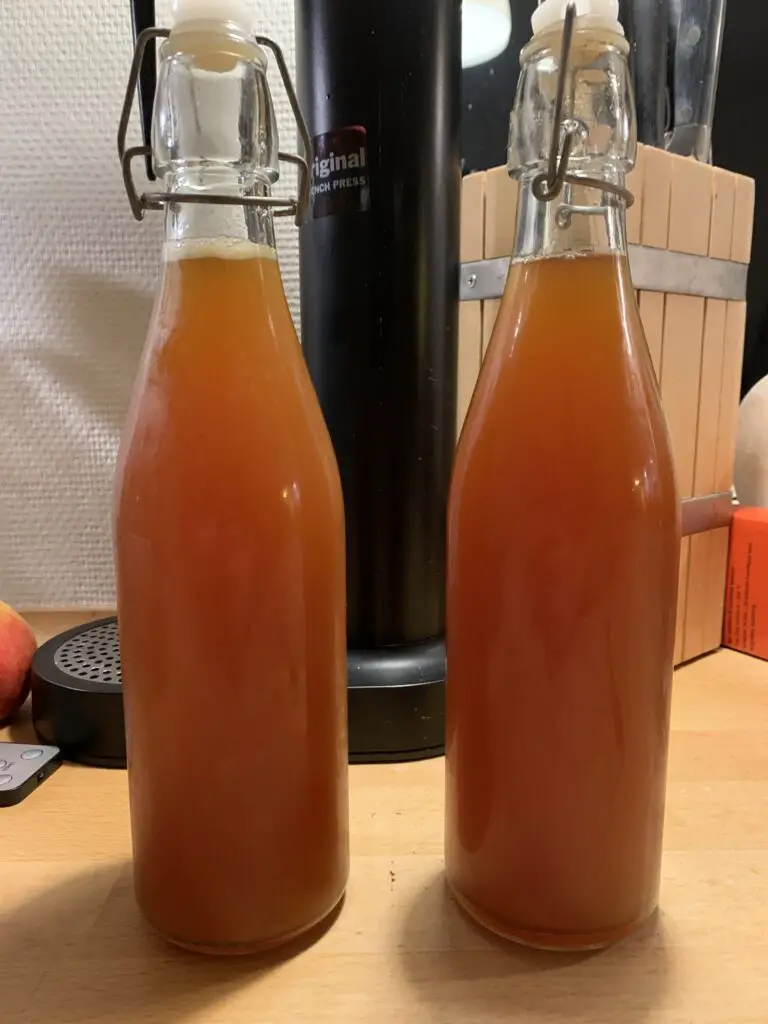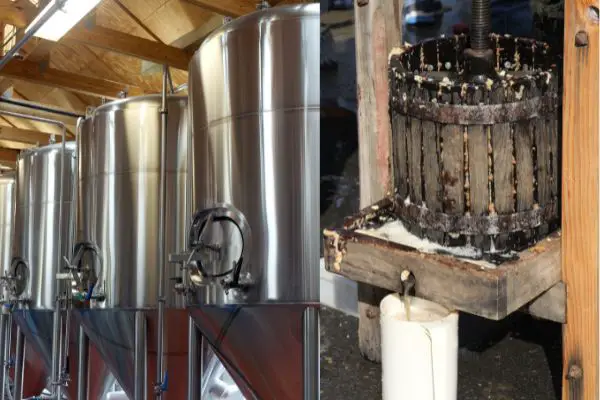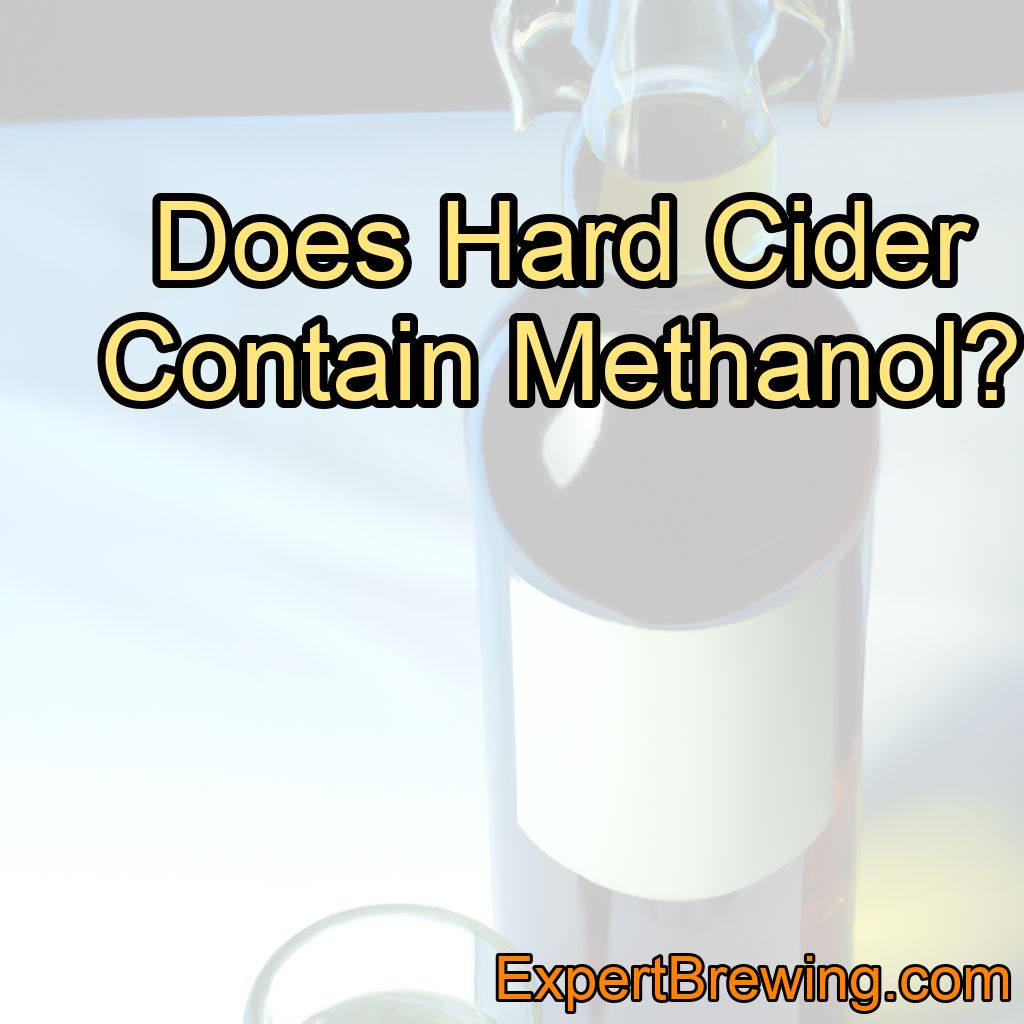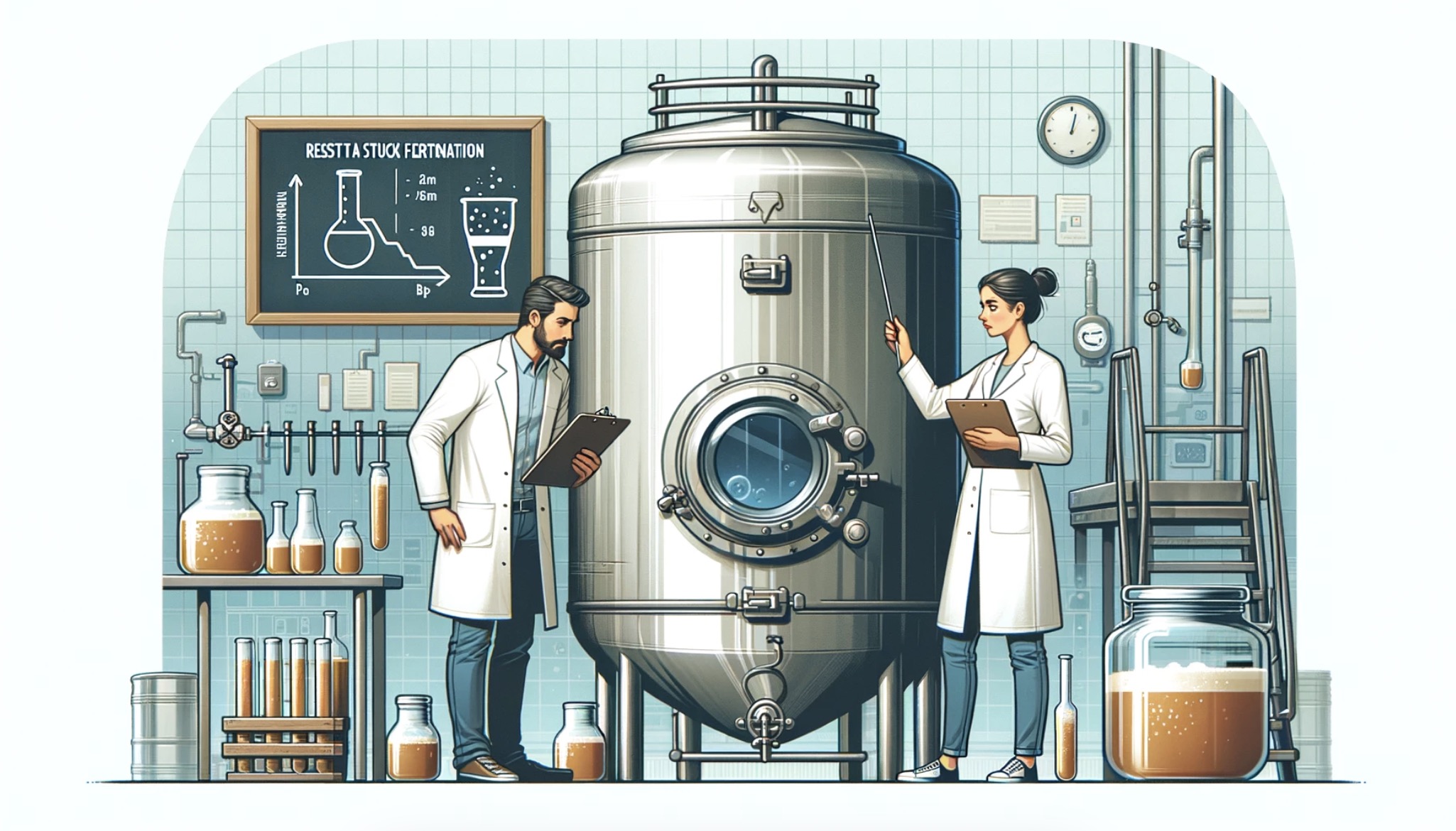As a long-time brewer and cider enthusiast, I’ve often been asked a question that seems to concern many people: Does hard cider contain methanol?
The quick answer is yes, but in very small amounts that are generally not harmful to us. It is formed naturally in the apple juice and is present at about 25 ppm, which is only 2.5% of the total methanol found in the pomace.
However, there’s a lot more to this story – a fascinating journey through the world of brewing and chemistry that I’d love to share with you.
Understanding Methanol
Before we dive deeper into the world of hard cider, let’s first understand what methanol is. Methanol, also known as wood alcohol, is a colorless, volatile liquid that often finds use in industrial and automotive applications.

However, it’s also naturally produced during the fermentation process of various alcoholic beverages, including hard cider.
Methanol is toxic to humans, and consumption in large quantities can lead to serious health issues like blindness or even death. Nevertheless, it’s important to remember that the amount of methanol present in commercially produced hard cider is typically negligible and not harmful.
How Does Methanol Get into Cider?
Methanol is produced when pectin, a naturally occurring substance in apples and many other fruits, is broken down during fermentation. Pectin is more abundant in windfall and overripe apples, which means that ciders made from these types of apples tend to have higher methanol levels.

However, it’s crucial to note that the levels of methanol in hard cider are typically much lower than those found in spirits such as fruit brandies or homemade distillates, which can contain dangerous amounts of methanol if not properly produced.
Crucially, the methanol content of hard cider has little to do with the fermentation itself (although yeast can contribute some) and everything to do with the apple juice.
Yes, you read it right – the main source of methanol in hard cider is the apple juice itself. Its already there!
Natural Methanol Content in Apples and other Fruit Juices
Methanol, a simple alcohol, is a naturally occurring compound found in fruits and vegetables. It is typically bonded to pectins, which are components of plant cell walls and the middle lamella.
During the processing of fruits and vegetables to create products like fruit juice, puree, or wine, methanol can be released from these pectin bonds.
In a study on methanol content in apples, various types of fruit juices, including apple juice, were examined for their methanol content. Apples, being a common fruit, were specifically studied to determine the methanol content in both the whole fruit and its corresponding juice.
The distribution of methanol between different components of the fruit, such as the mash, pomace, and juice, was also investigated.
The research revealed that the majority of potentially available methanol, more than 90%, remains in the pomace, which is the leftover pulp after juicing.
Only about 2.5% of the methanol present is transferred to the aqueous phase of the apple juice.
This means that the methanol content in fruit juice is significantly lower compared to the original fruit. As a result, consuming fruit juice is considered to be safe in terms of methanol exposure.
It’s important to note that the concentration of methanol in various fruit juices and smoothies can vary widely depending on factors such as the fruit type, processing methods, and the presence of pectin.

In conclusion, while methanol is naturally present in fruits and vegetables, its levels in commercially available fruit juices are relatively low and are unlikely to pose significant health risks.
The research findings emphasize that the consumption of fruit juices is generally safe, as the methanol content is significantly lower than that of the whole fruit.
The Role of Apple Cultivar and Juice Pasteurization
Apple variety plays a significant role in the methanol content of hard cider. Different cultivars contain varying levels of pectins and other compounds that can influence methanol formation during fermentation.
A study published in “Bioresource Technology” revealed that the methanol concentration in hard cider varies from 0.037% to approximately 0.091%. Notably, the legal limit of methanol for fruit brandy in the United States is 0.35% by volume or 280 mg/100 mL of 40% ethanol. This highlights the need for careful selection of apple cultivars when aiming to produce safe and high-quality cider.

Juice pasteurization is another factor that impacts methanol levels. Pasteurization affects the microbial content of the juice, which in turn can influence the fermentation process.
Different pasteurization methods can lead to variations in the final methanol content, necessitating a controlled and well-understood process to ensure consistency and safety in the final product.
Yeast Strain and Fermentation Conditions
The choice of yeast strain is critical in cider production, not just for flavor profile, but also for controlling methanol levels. Yeasts differ in their metabolic pathways and the compounds they produce during fermentation.
Some strains are known to produce lower levels of methanol while enhancing other desirable aroma compounds in cider. This underlines the importance of yeast genetics in the brewing process, necessitating careful selection and possibly genetic modification for optimal results.
Fermentation conditions, including temperature and duration, also significantly affect methanol production. Studies have shown that longer fermentation periods at lower temperatures can lead to higher methanol content.
This information is crucial for brewers who need to balance fermentation time and temperature to optimize flavor while minimizing methanol content.
The Fermentation Process
Fermentation is a naturally occurring process where yeast breaks down sugar into alcohol and carbon dioxide.
This is the fundamental process that fuels the production of our beloved hard cider.
During fermentation, a variety of alcohols are produced, the most abundant being ethanol (the alcohol we enjoy in our drinks) and minor quantities of methanol, mostly from pectin breakdown.
Distillation Makes Methanol Dangerous
In the distillation process, methanol is usually the first compound to be boiled off due to its low boiling point.
This is why homemade distillates can be risky; if the methanol is not properly discarded, it can lead to high concentrations in the final product.

Commercial distilleries have strict controls in place to prevent this, but the same cannot be said for homemade spirits.
Commercial Hard Cider: Safety Measures in Place
Commercial cider producers follow stringent safety guidelines to ensure their products are safe to consume. They use specific yeast strains and fermentation conditions to minimize methanol production. Furthermore, the methanol content in the final product is regularly tested to ensure it adheres to safety standards.
For brewers, the practical implications of managing methanol in cider are substantial. First and foremost, safety is paramount. Methanol, even in small quantities, can contribute to the harshness of the drink and, more importantly, pose health risks.

It’s a well-acknowledged fact in the brewing community that the unpleasant hangovers often associated with hard cider can be partly attributed to its methanol content, though factors like dehydration also play a role. Therefore, understanding how to minimize methanol formation without compromising the cider’s quality is a key skill for any cider brewer.
One practical approach is the careful selection of apple varieties. Since different cultivars yield varying levels of methanol, brewers can choose varieties known for lower methanol production. This selection, however, needs to be balanced with other desired characteristics like flavor, aroma, and sugar content.
Moreover, apple blends can be experimented with to achieve a desired balance between taste and safety.
Additionally, controlling fermentation conditions is a crucial aspect. Optimal temperature and fermentation duration should be tailored not just for flavor development but also to keep methanol levels within safe limits.
Advanced monitoring tools and fermentation technologies can aid brewers in achieving these precise conditions.
Safety Considerations and Regulatory Compliance for Industrial Brewers
Brewers must adhere to safety standards and regulatory limits for methanol content. As mentioned earlier, the legal limit for methanol in fruit brandy in the United States is 280 mg/100 mL of 40% ethanol, which serves as a guideline for cider brewers as well.
Regular testing of methanol levels during and after fermentation is essential to ensure compliance and consumer safety. This testing can be done through various analytical methods, including chromatography, which provides accurate and reliable results.
It’s also crucial for brewers to educate themselves and their staff on the signs and risks of methanol poisoning. While rare, particularly in professionally brewed products, understanding these risks is part of responsible brewing practices.
Latest Research Developments and Future Directions
The field of cider brewing is continuously evolving, with research offering new insights and techniques for managing methanol. Studies focusing on yeast genetics are particularly promising, as they open up possibilities for developing yeast strains that naturally produce lower levels of methanol.
This research is not just about reducing methanol but also about enhancing other desirable qualities in cider, such as aroma and taste.
Future directions in this field may include more advanced biotechnological approaches, such as gene editing and metabolic engineering. These methods could allow for more precise control over the fermentation process, leading to ciders that are not only safer but also of higher quality in terms of flavor and aroma profiles.
In conclusion, managing methanol in hard cider brewing is a multifaceted challenge that requires a blend of traditional brewing knowledge, modern scientific understanding, and a commitment to safety and quality. As brewers and biochemists, our goal is to continually advance our practices to produce ciders that are not only enjoyable but also safe for consumers.
Homemade Hard Cider: Precautions to Take
If you’re brewing hard cider at home, it’s important to use quality ingredients and proper fermentation techniques to minimize methanol production. Using fresh, ripe apples and a reputable yeast strain will go a long way toward ensuring a safe and tasty hard cider.
Conclusion
In conclusion, yes, hard cider does contain methanol, but in amounts so small that they are generally harmless to humans. The key is to consume commercially produced cider or homebrews made with high-quality ingredients and correct techniques.
Here are 10 facts to remember about methanol in hard cider:
1. Methanol is naturally created upon grinding and juicing apples.
2. Methanol is toxic in large amounts, but the quantities found in hard cider are typically not harmful.
3. Methanol in hard cider originates from the breakdown of pectin in apples.
4. Windfall and overripe apples can lead to higher methanol levels in cider.
5. Methanol levels in hard cider are lower than those in spirits like fruit brandies or homemade distillates.
6. Distillation can concentrate methanol if not done correctly.
7. Commercial cider producers adhere to strict controls to limit methanol content.
8. Commercial hard cider is regularly tested for methanol and other contaminants.
9. For homebrewing, use fresh, ripe apples and reputable yeast strains to minimize methanol.
10. The key to safe cider consumption is quality ingredients and correct brewing techniques.
So, next time you’re enjoying a refreshing glass of hard cider, you can do so with the knowledge that you’re not risking your health due to methanol. Cheers!
FAQs
What is hard cider made of?
Hard cider is made from fermented apple juice. The process involves crushing apples to extract the juice, which is then fermented using yeast. The yeast consumes the natural sugars in the juice and converts them into alcohol, resulting in hard cider. Some cider makers may also add additional ingredients such as yeast nutrients or other fruits to enhance the flavor profile.
Is hard cider beer or liquor?
Hard cider is neither beer nor liquor. It is a fermented alcoholic beverage made from apples or apple juice. While it shares some similarities with beer in terms of fermentation process, it is distinct in its own category. Hard cider typically has an alcohol content similar to beer, but it is not brewed like beer nor does it contain grains like beer. It is also not classified as a liquor, which generally refers to distilled spirits with higher alcohol content.
Is hard cider a liquor?
No, hard cider is not considered a liquor. It is a fermented alcoholic beverage made from apples or apple juice. Liquor typically refers to distilled spirits, which are produced through a process of distillation.
What are the ingredients in hard cider?
Hard cider typically contains apples, yeast, and sometimes additional sugars or sweeteners. The apples provide the base for the cider, while yeast ferments the sugars in the apples to convert them into alcohol. Some cider makers may also add sugar or sweeteners to adjust the sweetness level of the final product.
What foods have methanol?
Methanol can be found in small amounts in various foods and beverages. Fruits such as tomatoes, oranges, apples, and bananas naturally contain methanol. Additionally, certain fermented foods and drinks, like wine, beer, and spirits, may also contain trace amounts of methanol. It’s important to note that the levels of methanol in these foods are generally safe for consumption.
References
- Hang, Y. D. & Woodams, E. E. Influence of apple cultivar and juice pasteurization on hard cider and eau-de-vie methanol content. Bioresour. Technol. (2010). DOI: 10.1016/J.BIORTECH.2009.09.069. Link
- Liu, L. et al. Screening low-methanol and high-aroma produced yeasts for cider fermentation by transcriptive characterization. Front. Microbiol. (2022). DOI: 10.3389/fmicb.2022.1042613. Link
- Pieper, H. J., Oplustil, E. & Barth, G. Reduction of methanol formation during alcoholic fermentation. Biotechnol. Lett. (1980). DOI: 10.1007/BF00144243. Link
- Wilson, A. & Naiker, M. Biotechnological Modification of Cider Brewing Processes for the Enhanced Production of 2-Phenylethanol. Beverages (2022). DOI: 10.3390/beverages8040064. Link
- Inaba, S. Theoretical Study of Formation of Methanol under Hydrothermal Conditions. J. Phys. Chem. A (2020). DOI: 10.1021/ACS.JPCA.0C01617. Link




